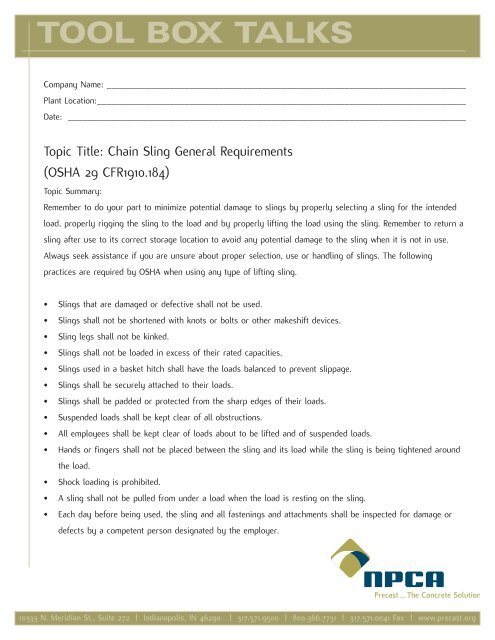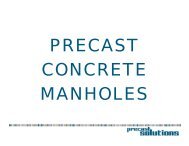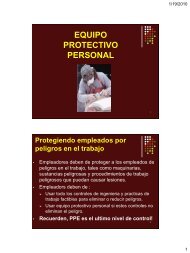Chains and Slings Toolbox Talks
Chains and Slings Toolbox Talks
Chains and Slings Toolbox Talks
Create successful ePaper yourself
Turn your PDF publications into a flip-book with our unique Google optimized e-Paper software.
TOOL BOX TALKS<br />
Company Name: __________________________________________________________________________<br />
Plant Location:____________________________________________________________________________<br />
Date: __________________________________________________________________________________<br />
Topic Title: Chain Sling General Requirements<br />
(OSHA 29 CFR1910.184)<br />
Topic Summary:<br />
Remember to do your part to minimize potential damage to slings by properly selecting a sling for the intended<br />
load, properly rigging the sling to the load <strong>and</strong> by properly lifting the load using the sling. Remember to return a<br />
sling after use to its correct storage location to avoid any potential damage to the sling when it is not in use.<br />
Always seek assistance if you are unsure about proper selection, use or h<strong>and</strong>ling of slings. The following<br />
practices are required by OSHA when using any type of lifting sling.<br />
• <strong>Slings</strong> that are damaged or defective shall not be used.<br />
• <strong>Slings</strong> shall not be shortened with knots or bolts or other makeshift devices.<br />
• Sling legs shall not be kinked.<br />
• <strong>Slings</strong> shall not be loaded in excess of their rated capacities.<br />
• <strong>Slings</strong> used in a basket hitch shall have the loads balanced to prevent slippage.<br />
• <strong>Slings</strong> shall be securely attached to their loads.<br />
• <strong>Slings</strong> shall be padded or protected from the sharp edges of their loads.<br />
• Suspended loads shall be kept clear of all obstructions.<br />
• All employees shall be kept clear of loads about to be lifted <strong>and</strong> of suspended loads.<br />
• H<strong>and</strong>s or fingers shall not be placed between the sling <strong>and</strong> its load while the sling is being tightened around<br />
the load.<br />
• Shock loading is prohibited.<br />
• A sling shall not be pulled from under a load when the load is resting on the sling.<br />
• Each day before being used, the sling <strong>and</strong> all fastenings <strong>and</strong> attachments shall be inspected for damage or<br />
defects by a competent person designated by the employer.<br />
10333 N. Meridian St., Suite 272 | Indianapolis, IN 46290 | 317.571.9500 | 800.366.7731 | 317.571.0041 Fax | www.precast.org
TOOL BOX TALKS<br />
Chain Sling General Requirements<br />
(OSHA 29 CFR1910.184)<br />
Additional Items Covered: ___ As noted below ___ None<br />
______________________________________________________________________________________<br />
______________________________________________________________________________________<br />
______________________________________________________________________________________<br />
______________________________________________________________________________________<br />
______________________________________________________________________________________<br />
______________________________________________________________________________________<br />
Presented by: __________________________________________________________________________<br />
Name Title<br />
Attendance: ____________________________________ ________________________________________<br />
____________________________________________ ________________________________________<br />
____________________________________________ ________________________________________<br />
____________________________________________ ________________________________________<br />
____________________________________________ ________________________________________<br />
____________________________________________ ________________________________________<br />
____________________________________________ ________________________________________<br />
____________________________________________ ________________________________________<br />
____________________________________________ ________________________________________<br />
____________________________________________ ________________________________________<br />
10333 N. Meridian St., Suite 272 | Indianapolis, IN 46290 | 317.571.9500 | 800.366.7731 | 317.571.0041 Fax | www.precast.org
TOOL BOX TALKS<br />
Company Name: __________________________________________________________________________<br />
Plant Location:____________________________________________________________________________<br />
Date: __________________________________________________________________________________<br />
Topic Title: Chain Sling Frequent Inspection<br />
(OSHA 29 CFR1910.184 <strong>and</strong> ANSI B30.9)<br />
Topic Summary:<br />
The purpose of this OSHA/ANSI rule is to ensure that only approved alloy grade chains are used for lifting <strong>and</strong> to<br />
establish minimum requirements for continuing use of the chains. Each lifting chain must be labeled with a tag<br />
that indicates the size, grade, rated capacity (also called the Working Load Limit) <strong>and</strong> reach of the chain. Chain<br />
slings <strong>and</strong> their components must be inspected on a schedule based on the severity of service, which at a<br />
minimum requires a monthly inspection for normal service <strong>and</strong> at a maximum requires a daily inspection for<br />
severe service.<br />
This <strong>Toolbox</strong> Talk will address the components of an effective “frequent” visual inspection program for Chain<br />
<strong>Slings</strong>. Documentation is not required, however any person who uses chain slings should be familiar with how to<br />
properly conduct this type of inspection.<br />
• Check Chain <strong>and</strong> attachments for wear, nicks, cracks, breaks, gouges, stretch, bend, weld splatter,<br />
discoloration from excessive temperature <strong>and</strong> throat openings of hooks.<br />
• Consult the manufacturer of your chains to determine the maximum allowable wear of chain links <strong>and</strong> hooks.<br />
• OSHA Table N-184-2 lists the minimum allowable thickness of a chain link for each chain size.<br />
• Check to ensure that chain links <strong>and</strong> attachments hinge freely to adjacent links.<br />
• Latches on hooks, if present, should hinge freely <strong>and</strong> seat properly without evidence of permanent distortion.<br />
• Any newly purchased chain that is equipped with a latch on the hook must be maintained with a properly<br />
working latch.<br />
• OSHA Table N-184-1 lists reductions to chain-rated capacities that must be made when a chain is exposed to<br />
high temperatures. Note that this Table requires the removal of any chain sling exposed to a temperature in<br />
excess of 1000º Fahrenheit, but rated capacities must be reduced for temperature exposures beginning at<br />
400º Fahrenheit <strong>and</strong> hotter.<br />
• Remember that exposure to high heat reduces the strength of the lifting chain’s steel alloy.<br />
Immediately remove any damaged or defective chains from use!<br />
10333 N. Meridian St., Suite 272 | Indianapolis, IN 46290 | 317.571.9500 | 800.366.7731 | 317.571.0041 Fax | www.precast.org
TOOL BOX TALKS<br />
Chain Sling Frequent Inspection<br />
(OSHA 29 CFR1910.184 <strong>and</strong> ANSI B30.9)<br />
Additional Items Covered: ___ As noted below ___ None<br />
______________________________________________________________________________________<br />
______________________________________________________________________________________<br />
______________________________________________________________________________________<br />
______________________________________________________________________________________<br />
______________________________________________________________________________________<br />
______________________________________________________________________________________<br />
Presented by: __________________________________________________________________________<br />
Name Title<br />
Attendance: ____________________________________ ________________________________________<br />
____________________________________________ ________________________________________<br />
____________________________________________ ________________________________________<br />
____________________________________________ ________________________________________<br />
____________________________________________ ________________________________________<br />
____________________________________________ ________________________________________<br />
____________________________________________ ________________________________________<br />
____________________________________________ ________________________________________<br />
____________________________________________ ________________________________________<br />
____________________________________________ ________________________________________<br />
10333 N. Meridian St., Suite 272 | Indianapolis, IN 46290 | 317.571.9500 | 800.366.7731 | 317.571.0041 Fax | www.precast.org
TOOL BOX TALKS<br />
Company Name: __________________________________________________________________________<br />
Plant Location:____________________________________________________________________________<br />
Date: __________________________________________________________________________________<br />
Topic Title: Chain Sling Periodic Inspection<br />
(29 CFR1910.184, ANSI B30.9 <strong>and</strong> ANSI B30.10)<br />
Topic Summary:<br />
OSHA requires a documented periodic inspection of chain sling components. The frequency of this inspection<br />
depends on the severity of service <strong>and</strong> must be conducted monthly if in severe service or annually (at a<br />
minimum) if in normal service. Periodic inspections must include all portions of the frequent inspection program,<br />
plus the additional components listed below.<br />
Each link-<strong>and</strong>-end attachment must be inspected individually, taking care to expose inner link surfaces of the<br />
chain <strong>and</strong> chain attachments. Worn links shall not exceed values in OSHA Table N-184-2 or the manufacturer’s<br />
recommendations. The following conditions warrant removal of the chain sling.<br />
1. Gouged or cracked links.<br />
Round off sharp nicks, but do not<br />
exceed maximum wear<br />
allowances.<br />
2. Stretched links.<br />
3. Worn links – refer to maximum<br />
wear allowances.<br />
4. Bent or twisted links.<br />
5. Excessive heat exposure – look<br />
for discoloration.<br />
6. Missing or illegible sling tag.<br />
7. Excessive pitting or corrosion.<br />
Inspect the load bearing points<br />
(where links contact one another)<br />
Look for link elongation, which is a<br />
sign of severe overloading.<br />
10333 N. Meridian St., Suite 272 | Indianapolis, IN 46290 | 317.571.9500 | 800.366.7731 | 317.571.0041 Fax | www.precast.org
TOOL BOX TALKS<br />
Chain Sling Periodic Inspection<br />
(29 CFR1910.184, ANSI B30.9 <strong>and</strong> ANSI B30.10)<br />
1. Throat opening may not increase<br />
by more than 15% of original.<br />
2. Excessive twisting from<br />
original plane.<br />
3. Worn load bearing point –<br />
maximum of 10 percent wear<br />
from original width.<br />
4. Evidence of stretching.<br />
5. Evidence of excessive<br />
heat exposure.<br />
6. Nicks, gouges, cracks, etc.<br />
7. If hook has a safety latch,<br />
verify that it seats properly<br />
<strong>and</strong> is functional.<br />
Remember to immediately remove any defective or damaged chain sling as determined by your inspection.<br />
Additional Items Covered: ___ As noted below ___ None<br />
______________________________________________________________________________________<br />
______________________________________________________________________________________<br />
______________________________________________________________________________________<br />
Presented by: __________________________________________________________________________<br />
Name Title<br />
Attendance: ____________________________________ ________________________________________<br />
____________________________________________ ________________________________________<br />
____________________________________________ ________________________________________<br />
____________________________________________ ________________________________________<br />
____________________________________________<br />
____________________________________________<br />
____________________________________________<br />
____________________________________________<br />
____________________________________________<br />
10333 N. Meridian St., Suite 272 | Indianapolis, IN 46290 | 317.571.9500 | 800.366.7731 | 317.571.0041 Fax | www.precast.org





